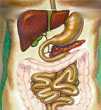What Is The Function Of The Digestive System
By: Dr. Rita Louise
 Each cell of the body requires a constant supply of nutrients to use as the basic building blocks of the body and for the hundreds of biochemical process that are continuously going on within the body. The function of the digestive system is to transform food into the energy the body needs to build, repair and fuel itself.
Each cell of the body requires a constant supply of nutrients to use as the basic building blocks of the body and for the hundreds of biochemical process that are continuously going on within the body. The function of the digestive system is to transform food into the energy the body needs to build, repair and fuel itself.
To be absorbed and used by the body, however, food substances must first be broken down into pieces small enough to cross the cellular membrane. The first step in this process is digestion. Digestion begins in the mouth. Food, once chewed, travels through the throat or pharynx to the esophagus and then on to the stomach. From the stomach, it passes into the small, then large intestines where it is further digested with the aid of bile and enzymes from the pancreas and liver, and finally absorbed. Any waste materials of this process exit the body through the colon and rectum.
Mouth
The mouth is the oral cavity where foods are received and prepared for digestion. The mouth is responsible for the secretion of salivary amylase, which begins the digestion process by converting starches into sugars.
Pharynx
The pharynx ,or throat, is a muscular tube that serves as a vehicle for both respiration and digestion. When we swallow, reflex movements of muscles in the pharynx propel food into the esophagus.
Esophagus
The esophagus is a tube that carries swallowed foods to the stomach.
Stomach
The stomach is a muscular organ that is located in the central/upper left hand region of the abdominal cavity. The function of the stomach is to break down food items. The stomach secretes digestive juices, such as hydrochloric acid and pepsin, to aid in this process. It’s muscular walls churn the food until it is in a semi-liquid form.
Small Intestines
The small intestines digest and absorb many of the foods we eat. In addition to secreting a strong mucus membrane to protect it’s walls from the strong acid food mixture that passes into it from the stomach, the small intestines (along with the liver and pancreas) secrete enzymes that help to digest proteins and carbohydrates and break them down into their simplest form. Once digested, nutrients are extracted and are absorbed by the body.
Large Intestines
The large intestine is responsible for the elimination of food materials that cannot be digested and assimilated by the body. It is also responsible for the re-absorption of water used during the digestive process. As food materials pass through the large intestine, friendly bacteria that live in the colon act upon this waste, producing vitamin K and some of the B-vitamins.
Liver
The liver is the largest gland in our bodies. It is located in the upper right portion of the abdominal cavity, with the lower edge of the liver extending just below the rib cage. The liver is responsible for a multitude of different functions, including:
- The synthesis of lipoproteins such as cholesterol.
- Synthesis of bile, which is necessary for fat digestion and absorption.
- Manufactures carnitine for use in cell mediated fat transport.
- Regulation of the amount of cholesterol circulating in the blood.
- The storage and releasing of glucose.
- Converts lactic acid into glycogen.
- Converts B vitamins into their active co-enzyme form.
- Coverts ammonia into urea, which is excreted by the kidneys.
- The production or synthesis of specific proteins such as albumin and blood clotting factors.
- The storage of substances such as glucose, fat soluble vitamins, including A, B12, D, E & K, folate, and minerals such as copper and iron.
- Modification and inactivation of hormones; i.e., the breakdown of hormones that have served their function.
- Detoxification of chemical elements whether ingested or inhaled.
- Removal of harmful substances from the blood and converts them into less harmful substances that can be eliminated.
Pancreas
The pancreas is a gland that is located in the upper left hand quadrant of the abdominal cavity. The pancreas houses the Isles of Landerhorn, which are responsible for regulating blood sugar levels. It also produces enzymes that digest fats, proteins and carbohydrates. In addition, the pancreas also produces an alkaline fluid, which neutralizes the acidity of foods as they exit the stomach and proceed into the small intestines.
© Copyright Rita Louise, Inc. – www.medical-intuitives.com. All rights reserved. This information is provided for educational purposes only. The descriptions of nutritional supplements are based on the historical usage of the various ingredients. They are not intended to promote any direct or implied health claims, and actual results of usage can vary. The statements on this Web site have not been evaluated by the U.S. Food and Drug Administration, and are not intended to diagnose, treat, cure, or prevent any disease.